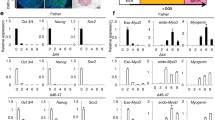Abstract
Induced pluripotent stem cell (iPSC)-based disease model is a useful tool that can represent the pathophysiology of patient organs that are inaccessible due to invasiveness. Here, we present a method to induce differentiation of Duchenne muscular dystrophy (DMD) patient-derived iPSCs into cardiomyocytes and restore dystrophin expression by exon skipping using antisense nucleic acids. This involves a 20-day multi-step culture process for differentiation to cardiomyocytes, followed by exon-skipping experiments. Additionally, RT-PCR, western blotting, and immunocytochemistry are used to confirm the restoration of dystrophin expression.
Access this chapter
Tax calculation will be finalised at checkout
Purchases are for personal use only
Similar content being viewed by others
References
Duchenne (1867) The pathology of paralysis with muscular degeneration (Paralysie Myosclerotique), or paralysis with apparent hypertrophy. Br Med J 2(363):541–542
Nigro G, Comi LI, Politano L et al (1990) The incidence and evolution of cardiomyopathy in Duchenne muscular dystrophy. Int J Cardiol 26(3):271–277
McNally EM (2007) New approaches in the therapy of cardiomyopathy in muscular dystrophy. Annu Rev Med 58:75–88
Eagle M, Baudouin SV, Chandler C et al (2002) Survival in Duchenne muscular dystrophy: improvements in life expectancy since 1967 and the impact of home nocturnal ventilation. Neuromuscul Disord 12(10):926–929
Mendell JR, Goemans N, Lowes LP et al (2016) Longitudinal effect of eteplirsen versus historical control on ambulation in Duchenne muscular dystrophy. Ann Neurol 79(2):257–271
Komaki H, Nagata T, Saito T et al (2018) Systemic administration of the antisense oligonucleotide NS-065/NCNP-01 for skipping of exon 53 in patients with Duchenne muscular dystrophy. Sci Transl Med 10(437). https://doi.org/10.1126/scitranslmed.aan0713
Lu QL, Rabinowitz A, Chen YC et al (2005) Systemic delivery of antisense oligoribonucleotide restores dystrophin expression in body-wide skeletal muscles. Proc Natl Acad Sci U S A 102(1):198–203
Rovina D, Castiglioni E, Niro F et al (2020) “Betwixt mine eye and heart a league is took”: the progress of induced pluripotent stem-cell-based models of dystrophin-associated cardiomyopathy. Int J Mol Sci 21(19). https://doi.org/10.3390/ijms21196997
Okita K, Yamakawa T, Matsumura Y et al (2013) An efficient nonviral method to generate integration-free human-induced pluripotent stem cells from cord blood and peripheral blood cells. Stem Cells 31(3):458–466
Rodriguez ML, Graham BT, Pabon LM et al (2014) Measuring the contractile forces of human induced pluripotent stem cell-derived cardiomyocytes with arrays of microposts. J Biomech Eng 136(5):051005
Chiba S, Lim KR, Sheri N et al (2021) eSkip-Finder: a machine learning-based web application and database to identify the optimal sequences of antisense oligonucleotides for exon skipping. Nucleic Acids Res. https://doi.org/10.1093/nar/gkab442
Author information
Authors and Affiliations
Corresponding author
Editor information
Editors and Affiliations
Rights and permissions
Copyright information
© 2023 The Author(s), under exclusive license to Springer Science+Business Media, LLC, part of Springer Nature
About this protocol
Cite this protocol
Sato, M., Shiba, N., Miyazaki, D., Shiba, Y., Nakamura, A. (2023). Restoring Dystrophin Expression with Duchenne Muscular Dystrophy Exon 45 Skipping in Induced Pluripotent Stem Cell-Derived Cardiomyocytes. In: Maruyama, R., Yokota, T. (eds) Muscular Dystrophy Therapeutics. Methods in Molecular Biology, vol 2587. Humana, New York, NY. https://doi.org/10.1007/978-1-0716-2772-3_8
Download citation
DOI: https://doi.org/10.1007/978-1-0716-2772-3_8
Published:
Publisher Name: Humana, New York, NY
Print ISBN: 978-1-0716-2771-6
Online ISBN: 978-1-0716-2772-3
eBook Packages: Springer Protocols




